The Top Ten Cryptozoology Stories for 2007
Posted by: Loren Coleman on November 27th, 2007
The Top Ten Cryptozoology Stories for 2007
by Loren Coleman, Cryptozoologist and Author, Mysterious America, Cryptozoology A to Z, and other books.
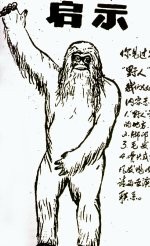
From Bigfoot to Yeren, and from dwarf killer whales to dwarf manatees, it was quite a year.
Welcome to this year’s top stories in cryptozoology. It wasn’t heaven during 2007 for the cryptids, but instead seemed to have been a year of reflection, mistakes, fakes, and a few new finds.

In the 1940s, the Scottish-born American zoologist Ivan T. Sanderson (photo with lemur) began using a word he coined, “cryptozoology,” to describe a new discipline of science that investigates hidden, yet-to-be-discovered large animals. In the late 1950s, after a decade of correspondence with Sanderson, Belgian zoologist Bernard Heuvelmans began formalizing “cryptozoology.”
Today, cryptozoology is to be found from academia to museum exhibitions, from new television series to tee-shirts.
My annual picks are cryptozoological events, which became newsworthy during 2007 (even though they may have happened in an earlier year).
Here is my top ten list of the cryptozoology accounts of most interest to the public, cryptozoologists, Bigfooters, fans, friends, foes, and the media during this year. They may not be the most remarkable but they are the ones that garnered the largest media reaction and greatest public discussions on our favorite topic for 2007:
1. Holmes Nessie Videotaped
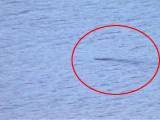
Gordon Holmes, a 55-year-old lab technician, was at a lay-by about 70 feet above Loch Ness on May 26, 2007, when he captured digital video of what he said was “this jet black thing, about 4 to 5 feet (1.4 m) long, moving fairly fast in the water.” Adrian Shine, a Nessie skeptic, described the footage as among “the best footage ever seen.” The footage shows no points of reference to demonstrate scale.

At Cryptomundo, the film’s credibility was questioned early, due to Holmes’ past claims of filming black fairies. Many also wondered aloud if this video was nothing more than an otter swimming in the loch.
Nevertheless, media interest in Nessie and other lake monsters was extremely high in the wake of the Holmes video, which was broadcast on BBC Scotland on May 29, 2007, and on CNN on June 1, 2007.
In early September 2007, a brief Internet frenzy occurred regarding the 20-minute video of six Lake Tianchi Monsters in China. A closer look at the Chinese video seems to show probable waterfowl.
Holmes video: here and here. Chinese video: here
2. Shunka Warak’in Mount Found

After 121 years, the mysterious taxidermy mount of the Shunka Warak’in (a wolf-hynea-like cryptid), from 19th century Montana, was found. The wolf-like creature prowled the Madison Valley, Montana, destroying livestock and reportedly letting out ungodly screams.
After being killed and stuffed in 1886, the taxidermy mount disappeared. In 2007, the body was tracked to the Idaho Museum of Natural History in Pocatello. It will be on display at Montana’s Madison Valley History Museum in May 2008. Hopefully DNA testing will finally determine this mystery candid-like species’ identity.
3. Bigfoot Film’s 40th Anniversary Celebrated
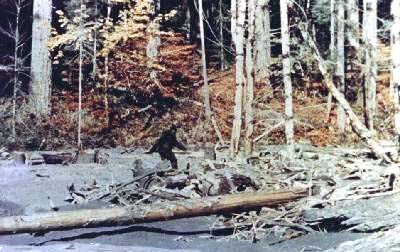
At Bluff Creek, California, an apparent female Bigfoot was filmed on October 20, 1967, by Roger Patterson, with assistance on his search from Bob Gimlin. Because this was the 40th year since that event, Bigfooters talked a great deal about the film in the last few months, attempted one gathering in California that was cancelled due to people not wanting to pay the high ticket prices, and quickly organized a celebration at Willow Creek. No one has proven the footage was faked, and during 2007, the merits of the footage were discussed frequently.
For more on the iconic imagery of Patty, plus clips from the footage, please see here.
4. Cuero Chupacabras Killed
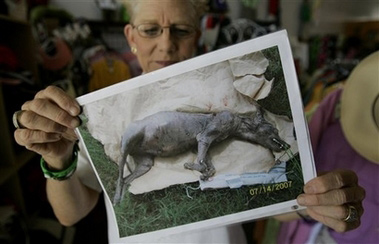
In July 2007, the pictured animal was hit by a car and killed on Phylis Canion’s property, on Buenger Road off U.S. Highway 183 south of Cuero, Texas. Canion (holding the photo) had said she saw this “animal” for two years roaming her property. The immediate cry heard throughout the media was “Chupacabras” (sometimes incorrectly spelled without the “s”). Before the frenzy was over, tee-shirts had appeared on the scene.
In early November, the DNA results from tests run on the so-called “Chupacabras” by biologists at the Texas State University found the dead animal was a coyote (Canis latrans). In the end, the “Cuero Chupacabras” was only a mangy canid.
5. Dwarf Killer Whale, Dwarf Manatee, Giant Peccary, and More Discovered
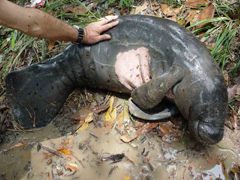
The year was filled with a number of new species being announced. In a paper entitled the “Dwarf Form of Killer Whale in Antarctica,” the first 2007 issue of the Journal of Mammalogy summarized findings that few paid any attention to. Meanwhile, media accounts of the six years ago reports of the giant peccary in Brazil, or the more recent discovery of a dwarf manatee (above) in the Amazon spread widely.

At Cryptomundo, other new species findings, from a new monkey in Uganda to a new clouded leopard in Southeast Asia, from new limbless amphibians in India to walking sea anemomes off the Aleutians, projected hopes for more cryptozoological surprises for the future.
The list is a long one of the 2007 discoveries. Reports of these new species were shared often at Cryptomundo, and included news of bizarre octosquids, legless amphibians, ethnoknown vipers, beaked whales, flying foxes, eel-like catfishes, golden frogs, Thai geckos, Hawaiian sharks, Thai mountain frogs, Panama salamanders, sucker-footed bats, cloud-forest rats, Madagascar millipedes, chicken-eating tarantulas, and Steve Irwin’s new turtles.
Also, an extinct echidna was rediscovered, an extinct blind snake was found, the first Zanzibar coelacanth was caught, the first Sumatran striped rabbit photographed, and the first video footage of elusive Borneo rhinos was captured. It was a good year. (Compare that list to a couple missteps – a fake photo of the allegedly extinct-in-the-wild South China tiger and a hoax photo of a supposedly rediscovered parrot.)
6. Nguoi Rung Kidnap Victim Returned
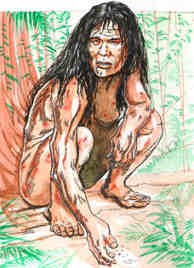
Ro Cham H’pnhieng, 27, was discovered on the edge of the Cambodian jungle in January 2007, after she was caught trying to steal food left under a tree. She was seen with a hairy Wild Man, a Nguoi Rung. Reportedly, she had been kidnapped in 1989 by the wild people and taken into the jungle. Attempts to find the Nguoi Rung (below) were made, with no positive results.

In October 2007, after Ro Cham H’pnhieng’s family tried to have her live with them again, after several incidents of her running away into the forest, she escaped for the final time, apparently to return to the Forest People. She had made her choice, her family felt.
7. Cryptozoology TV Succeeded
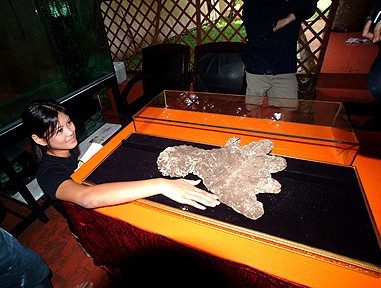
During 2007, two down-to-earth field-oriented cryptozoology documentary series were broadcast on cable television. Both programs, each in their first seasons, received high ratings and good reviews.
The SciFi Channel’s “Destination Truth” was produced by the Mandt Brothers, and the History Channel’s “MonsterQuest” was produced by White Wolf Productions. “MonsterQuest’s” episode on “Sasquatch Attack” created quite a stir in the Bigfoot community. The program dealt with an apparent rock-throwing incident that occurred during the actual filming of the program. Furthermore, DNA tests were conducted on old blood and tissue samples left on screws said to have been stepped on by a Bigfoot.
8. Mapinguary and Yeren Reemerged
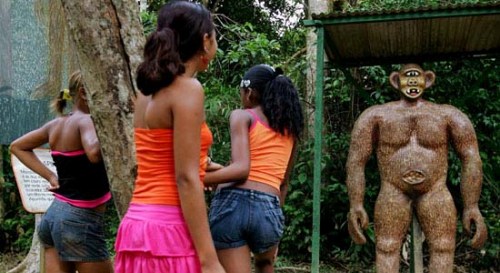
The Mapinguary (pronounced MA-ping-war-E), the huge unknown anthropoid ape or the giant sloth-like monster of the Amazon, was in the news again in June and July 2007. New attention from The New York Times, revisited the topic early in the year, and spread to the UPI and NBC’s “Today Show.”
“It is quite clear to me that the legend of the Mapinguary is based on human contact with the last of the ground sloths,” said David Oren, former director of research at the Goeldi institute in Belém, at the mouth of the Amazon River.
The South American focus continued with the Centre for Fortean Zoology’s end of November excursion to Guyana to look into reports of the Didi and the overlap with the accounts of the Mapinguary.
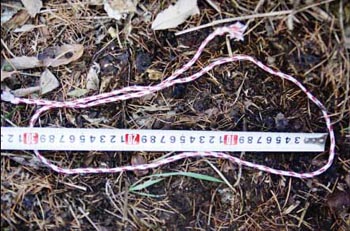
This is one of the Yeren foot impressions discovered in November 2007.
New sightings of Chinese “Wild People,” two Yeren in Shennongjia, were reported on November 18, 2007. According to the eyewitnesses, the two Yeren were skinny and covered with black hair. The taller one was about 1.7 meters high and the other one was approximately 1.3 to 1.4 meters. On November 22, members of the China Association for Scientific Expedition took plaster casts of impressions identified as two “Wild Men” footprints left along the Licha River where the two mysterious creatures had been spotted.
9. Jacobs Creature Photographed
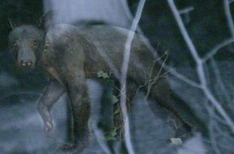
With timing keyed to the 40th anniversary of the Patterson-Gimlin footage, two Pennsylvania trailcam photographs were released for maximum exposure labeled to indicate they showed a “juvenile Sasquatch.” The two images and an accompanying photograph of two bear cubs were reported to have been taken on September 16, 2007, by a Bushnell game camera placed in a Pennsylvania forest by an individual named R. Jacobs.
The “Jacobs Creature,” or “Jacobs Photograph,” as it was called, resulted in several ridicule-filled media reports and much debate within the Bigfoot community on the worth of the photographs. Cryptomundo noted they appeared to be of a “mangy bear,” and anthropologist Jeff Meldrum agreed, as did the Pennsylvania wildlife department. A few saw in the photographs a youthful Bigfoot.
Were other frames of the trailcam sequence being hidden from the public? Why were the photographs withheld for a month? What is the entire story of the Jacobs cryptid? At year’s end, many questions remain unanswered about the events surrounding the mystery photos.
10. Heuvelmans Biography Published
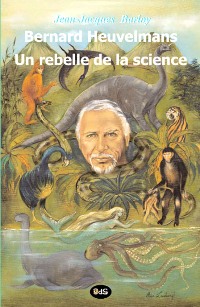
The biography of one of the “Fathers of Cryptozoology,” Bernard Heuvelmans, was published for the first time in 2007, in French. Jean-Jacques Barloy, who wrote the biography, “Bernard Heuvelmans, un rebelle de la science” (1st volume of the “Bibliothèque Heuvelmansienne,” Editions de l’Oeil du Sphinx, juin 2007) – Bernard Heuvelmans: A Rebel of Science – would win an award for his writings, the “Grand Prix de l’Imaginaire 2008” (category essay). The announcement of the prize was made on November 3, 2007.
Plans are in place to have the Heuvelmans biography translated into English, and published in a forthcoming year.
As far as obituaries for 2007, the most prominent in cryptozoology was the death of Bigfoot researcher Archie Buckley, an early and significant member of hominology, a cornerstone founder of the Bay Area Group, the Sasquatch research collective of the San Francisco Bay area. Buckley died on June 18, 2007.
Update:
On the first day of 2008, I learned that an individual of significant in hominology had passed away, late in 2007.
Sadly, word reached me of the death of a figure important to the investigation of the Skookum Cast. University of Washington professor emeritus of anthropology, World War II veteran, consummate teacher, and beloved father, husband and friend of cryptozoology, Dr. Daris R. Swindler, 82, had passed away on December 6, 2007, and a memorial service was planned for late January 2008.
For a more complete obituary, see:
“Skookum’s Dr. Swindler Dies Suddenly”
+++
At the end of the year, Loren Coleman on Saturday, December 1, 2007, delivered his talk, “Introduction to Cryptozoology,” at 1:00 PM, at the American Museum of Natural History, New York City, New York, in conjunction with their then-current exhibition, Mythic Creatures.
Loren Coleman has been involved in cryptozoology since 1960. He is the author of over 30 books and hundreds of articles, appears frequently in documentaries, and is the director of the International Cryptozoology Museum in Portland, Maine.
Coleman may be reached via email at [email protected]
For more information, see here.

About Loren Coleman
Loren Coleman is one of the world’s leading cryptozoologists, some say “the” leading living cryptozoologist. Certainly, he is acknowledged as the current living American researcher and writer who has most popularized cryptozoology in the late 20th and early 21st centuries.
Starting his fieldwork and investigations in 1960, after traveling and trekking extensively in pursuit of cryptozoological mysteries, Coleman began writing to share his experiences in 1969. An honorary member of Ivan T. Sanderson’s Society for the Investigation of the Unexplained in the 1970s, Coleman has been bestowed with similar honorary memberships of the North Idaho College Cryptozoology Club in 1983, and in subsequent years, that of the British Columbia Scientific Cryptozoology Club, CryptoSafari International, and other international organizations. He was also a Life Member and Benefactor of the International Society of Cryptozoology (now-defunct).
Loren Coleman’s daily blog, as a member of the Cryptomundo Team, served as an ongoing avenue of communication for the ever-growing body of cryptozoo news from 2005 through 2013. He returned as an infrequent contributor beginning Halloween week of 2015.
Coleman is the founder in 2003, and current director of the International Cryptozoology Museum in Portland, Maine.










I’m sure glad that Mangy Bear made the list! Woo Hoo! No list would be complete without the Mangy Bear.
Good list, Loren.
I agree with bucko. I feel that the finding of the Shunka Warak’in was the best story of the year. It shows that with the right luck and enough digging around, good things can happen!! And, by the way, PLEASE, let’s put an end to the mangey bear, dog, coyote, and what ever else stories! These are sssssoooooo old!
This HAS been a great year in the Cryptid World!
Thanks for the terrific blog, gentlemen, and a special thanks to Loren, for sharing so much with us. It shows. Cryptomundo is AWESOME, and I am proud to refer my friends here!
Out of all those stories, the dwarf manatee takes the cake. I never thought they’d ever discover another species of manatee, and the fact that it’s a dwarf variety is even more amazing! The only thing that could be better than that is if the Steller’s Sea Cow was rediscovered(I wouldn’t hold my breath for that one, though). I agree with Squatch-toba, I’m getting a little sick of the mangy canid “Chupacabras”. Every description I’ve ever heard of the Chupacabras is of a humaniod/reptilian/alien sort of thing with quills on its back, nothing that could ever be confused with a coyote!
What a great year for cryptozoology, although as I recall the field lost several valuable members due to illnesses and other maladies. We should not forget them.
And the word of the year? MANGE!! 🙂
Oh, I won’t forget the fallen. I publish an annual list of those who have died, but closer to the end of the year.
Here’s last year’s list of obits: “Cryptozoologists Who Passed Away in 2006.”
All of my past lists are found on http://www.lorencoleman.com
There’s many more to come.
I agree with Kittenz. Thanks, Loren and company for bringing us such an excellent blog site.
I am a little surprised that “mange” didn’t seem to make Cryptid of the Year.
Thanks, however, for the trail-cam photo apparently showing colorfully-dressed female Mapinguary, with a male in attendance showing the marked attractiveness dimorphism between sexes of that species. 😀
Personally I think space could have been made on this list for the March video from Peguis, Manitoba, in my opinion the most intriguing video sasquatch other than Patty. How about an honorable mention?
But of the ones on the list, the dwarf manatee is the coolest.
Yep, I agree. The discovery of the dwarf manatee is the koolest on the list. It’s a cute little thing too. Too bad you couldn’t have added the discovery of the Big Ones to the list of ’07, Loren. Man won’t that just be awesome! Well, with any luck, maybe, just maybe, ’08 will be the year of the Big One’s discovery. A lot of trail cams being put in places more so than before, I believe, would help. I know I will be spending more time in the bush next year, that’s for sure.
I wonder whats going to happen in 2008?
The great Marc Van Roosmalen is continuing his quest for New species, among them a Pygmy or Dwarf tapir and Arboreal Giant Anteater, a White-Throated Black Jaguar. He is on the track of at least 20 new monkey species as well. Marc is a field biologist and conservationist in the Amazon. I wish him continued success in the coming years.
WATCH THIS SPOT to find out!
Way to go Cryptomundo! Heres to another terrific year Loren and fellow Cryptomundians! I’m looking forward to yet another successful year, full of intrique, quests, discovery and mystery! Best to all.
Thanks for another great year Loren! Here’s looking to 2008!
The best story of the year (to my mind) is the Holmes video. Particularly since Holmes is such an eccentric character.
I guess the the Malaysia ‘hoax’ was in 2006, time is flying by. I still can’t believe Bernard Heuvelmans considered the PG film a hoax, I wonder if he’d have a different opinion after all the recent analysis.
The second most interesting story was the Nguoi Rung tale.
A most unusual “love story.”
Thanks for the list, Loren. And for everything you do!!!
Loren–Excellent rundown of the Top Stories in Cryptozoology for 2007! Superb!
And let’s not forget all the wonderful creatures that were discovered or rediscovered. That brings us a lot of hope for 2008!
Thank you for all you do to make life and cryptozoology interesting and fun!
Thank you Loren for posting this. Here’s to a hopeful and good 2008 and beyond.
The sheer number of new species discoveries and rediscoveries, some of large animals, happening this year in this world where the wild lands are ever dwindling and humans encroach further and further into nature’s space, is cause for some amount of celebration for me. It is heartening to think that for all the species that have met with extinction, there are still those out there to be found, or that have dodged their own supposed extinctions.
These new species discoveries are the most concrete and exciting stories for me, but of course I love it all. I especially found the whole Gordon Holmes video affair to be quite bizarre and amusing. Not only was it a weird video (whatever happened with that anyway?), but the man behind it was himself so eccentric and filled with slightly off kilter, far out ideas that I couldn’t help but feel drawn to and amazed by this odd gem of a story.
As always it was interesting to have another round of debate on the topic that never grows old even after 40 years and of course I mean Patty and the PG footage. Those threads just take off through the roof, don’t they?
My award for photo that was talked about way more than I ever thought it would be and perhaps more than I think it deserved to be is: the Jacob’s Bear, er, Creature. 🙂 I hear the bear is living it up in a beach resort from all of the royalties it received from the coverage and will phone in its acceptance speech.
Like so many others here, I think this is a superb site and my favorite of all. Let’s hope that the following years brings with it many more exciting surprises.
In regard to the oft-debated spelling of Chupacabra/s, I offer this to ponder: The term apparently began with the first sightings on Puerto Rico, where I live. So, I can tell you the final “s” on a word isn’t often used. Puerto Ricans don’t say, for instance, “Gracias,” they say “Gracia” and “do’ ma'” for “dos mas.” It is likely to assume that perhaps this is where the confusion began. Also, if something sucks one goat only, it technically would be a Chupacabra (goat-sucker) whereas the other implies sucking (the blood from) multiple goats.
Okay, I’m not sure I want to spend time doing this ~ again, but here goes.
First, doesn’t “eireman” = Irish man, thus meaning this is an Irishman in Puerto Rico?
Well, there’s no reason anyone should listen to a Scottish-Cherokee in Maine, I suppose.
Therefore, I turn again to my researcher friend Scott for his insights:
Very entertaining overview of the year’s events.
May I offer a friendly suggestion? Perhaps it would be advantageous to the field of cryptozoology if two annual lists were conceived. The first would be very much like the one above, detailing crypto-animal news from a pop-culture perspective.
The other list would be restricted to scientific or academic news that relate to the topic of crypto-animals, newly discovered animals (of the year), or intriguing and plausible cryptid possibilities.
The second list would be big on such discoveries as those found in Vietnam this year. And not so big on poltergeist/sasquatch TV cable entertainments.
Year of the Mange ~ that’s awesome! As always, some creatures turned out to be real, and science had to take note. So the world is not as simple as people like to think. Happy Holidays everybody!
2007 was an even better year in cryptozoology than 2006, the newly reported discoveries were simply amazing! This site is one of my absolute favorites as well and here’s looking forward to 2008, I can’t wait to see what the new year will bring! Hopefully next year will be the year of the big fella. 🙂
The video of the giant Humbolt or Architeuthis – whichever it was – deserves a mention.
Nothing on Big Man from South Dakota
No new significant sightings of sasquatch
No reports on orang pendek
Hmm. A slow year from the hominid perspective?
Well, sschaper’s comment about the filming of the giant squid is a year off. It was a big story in December 2006, and was on last year’s “top cryptozoology stories” list.
The Jacobs creature was no bear. Listen to Dr. Jeff Meldrum say in his own words the limbs are too long for a bear:
It was published later on in a science magazine used in classrooms that scientists worked out the size of the creature on location using the game camera and foot placement with an adjustable replica model. It had 22 inch long arms and a torso that was 18 and 3/4. That is impossible for a bear that has a torso longer than the limbs.